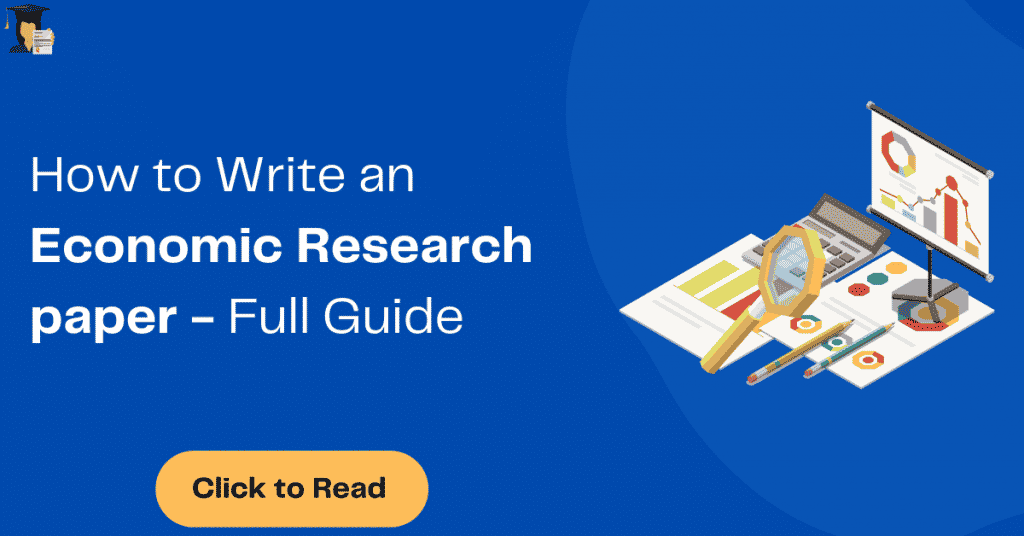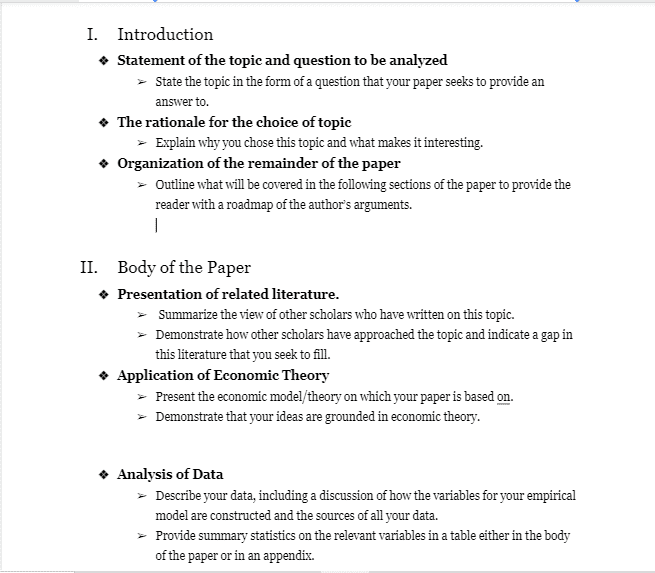How to write an economic research paper or term paper is an essential skill for any student to master, especially in your economic courses. Not only will it help you succeed in your studies, but it will also give you a valuable tool that you can use in your future career.
What is an Economic Research Paper?
An economic research paper is a type of paper that presents an argument or analysis of economic data. These papers can be written on various topics, from economic theory to empirical economic data. The purpose of this paper is to present a new argument or perspective on economic data.
So why is it essential for you? The tasks will allow you to share your knowledge of the industry, so presenting your new ideas will heavily influence the future of economic policy. It will also allow you to develop your analytical and writing skills and the ability to think critically about financial principles.
So in this article, we will briefly look through the overview of an economic research paper and offer tips on how to write one effectively.
Types of Economic Research Papers
Writing an economic research paper is sometimes overwhelming for students and scholars. For you to better understand what is expected when given the task here are the two types of economic research papers you should know.
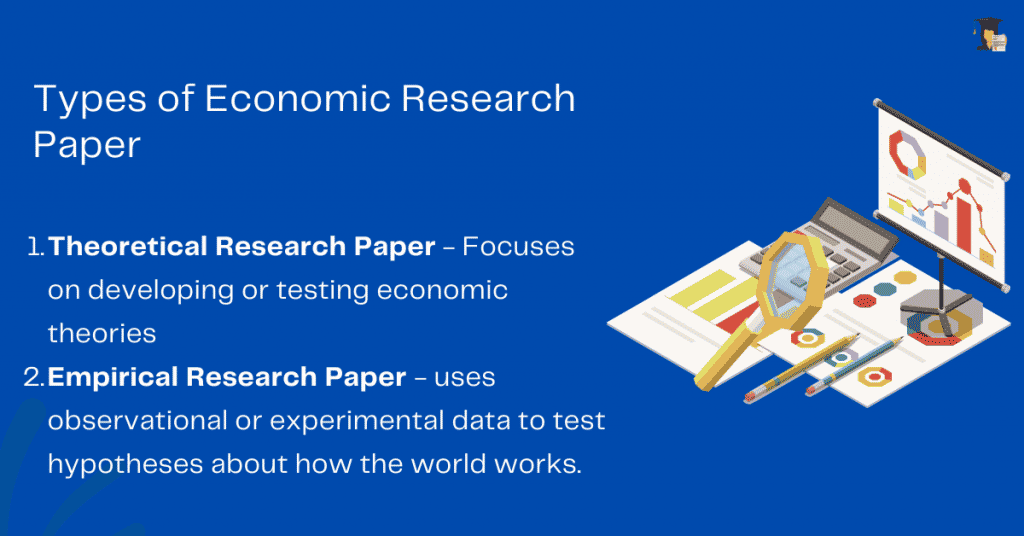
Theoretical Research Paper
A theoretical research paper is a type of economic research writing that focuses on developing or testing economic theories. Economic theories are models that explain how the economy works. Additionally, they can describe how people make decisions, determine prices, or grow economies.
Examples of theoretical economic research paper
Here are three examples of theoretical research papers:
- “ Trade and Transportation.”- This looks at how the world’s economic system relies heavily on trade and transportation of goods & services.
- “The Impact of globalization on International Trade”: This looks at how globalization has affected international trade in terms of increasing trade volume and the changing composition.
- “Economic Development in Sub-Saharan Africa”: This discusses the challenges and opportunities faced by sub-Saharan Africa in terms of economic development. It covers topics such as poverty, infrastructure, and trade.
Empirical Research Paper
An empirical research paper is a type of economic research writing that uses observational or experimental data to test hypotheses about how the world works.
- Observational pieces– presenting an evaluation of data that is already collected.
- Practical pieces- presenting a collection of new data specifically for the study.
Examples of empirical economic research paper
Here are three examples of empirical research papers:
- “A path to economic equality.”- The document looks at how discrimination has affected the minorities in society and the organization of the necessary steps taken to dismantle this narrative.
- “Is capitalism worth it?” The document looks at how capitalism has heavily affected people’s daily lives and how they navigate their ways through capitalism.
- “How the unemployment rate affects today’s world economy.” – With the rise of unemployment, the document looks at how this is a significant factor affecting today’s economy.
Economic Research Paper Outline Template
Components of a Theoretical Paper
Below is what a theoretical economic paper comprises of:
Abstract
In theoretical economic research writing, the abstract section is where you will describe what goes into your work and the research question, aims of the research, etc. It is where you will also provide an overview of your theoretical model and its application to the more significant body of economic thought. Remember to be concise and transparent in your writing, as the abstract provides a general overview of your work rather than a detailed explanation.
Introduction
The introduction section of theoretical economic research should provide your readers with a clear roadmap for what is to come and help them better understand your work’s significance.
The introduction section contains several components:
- It should provide an overview and explain why the issue is essential.
- It should state the research question(s) addressed in the paper.
- It should outline the structure of the paper and explain how the various sections will contribute to answering the research question(s).
- It should provide a brief overview of the data and methods used in the paper.
Literature review
The literature review section of theoretical economic research writing provides an overview of the existing knowledge on the chosen topic. This section typically begins with a summary of the current state of research, followed by a critical evaluation of the strengths and weaknesses of the existing literature. Furthermore, the literature review then identifies gaps in the recent analysis and suggests future research directions. To write an effective literature review, it is crucial to clearly understand the components of a research exam and the role each section plays.
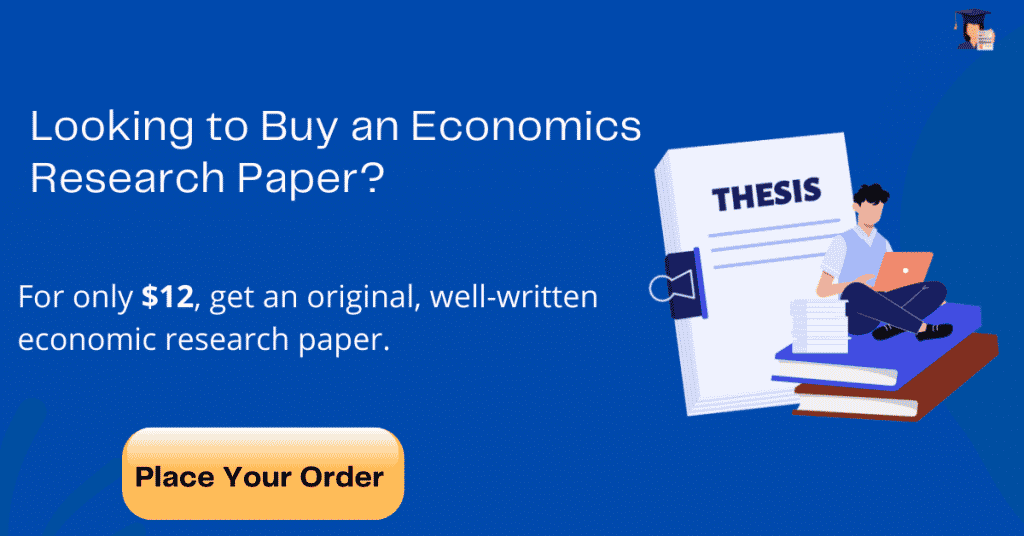
Economic Model
In a theoretical economic research writing, the economic model section describes the theoretical framework within which the analysis is performed. This includes specifying the assumptions about how the economy works, what factors are essential, and how they interact. The economic model section also outlines the theoretical predictions derived from this framework. Also, these predictions can be compared with empirical data to test the validity model. The economic model section provides a clear description of the theoretical foundation on which the exam is based.
Conclusion
The conclusion section of theoretical economic research writing rarely includes new academic material. The conclusion aims to summarize your main findings of the document and discuss their implications. In some cases, the conclusion may also include discussing future research directions. However, the focus should be on summarizing and synthesizing the material that has already been presented in the paper.
Bibliography/Reference
The bibliography reference section of a theoretical economic research exam typically includes three types of resources: primary sources, secondary sources, and tertiary sources. The reference section helps to establish the research paper’s foundation in existing scholarships and to situate the form within the broader conversation about the topic at hand.
- Firstly, primary sources are the original data or theoretical work on which the research is based. These might include data from surveys, experiments, or academic documents introducing new models or assumptions.
- secondly, secondary sources are works that interpret or analyze primary sources. These might include literature reviews or theoretical papers that build on or critique existing models.
- Finally, tertiary sources provide an overview of a topic area or a specific secondary source. These might include textbooks or introductory articles in theoretical economics journals.
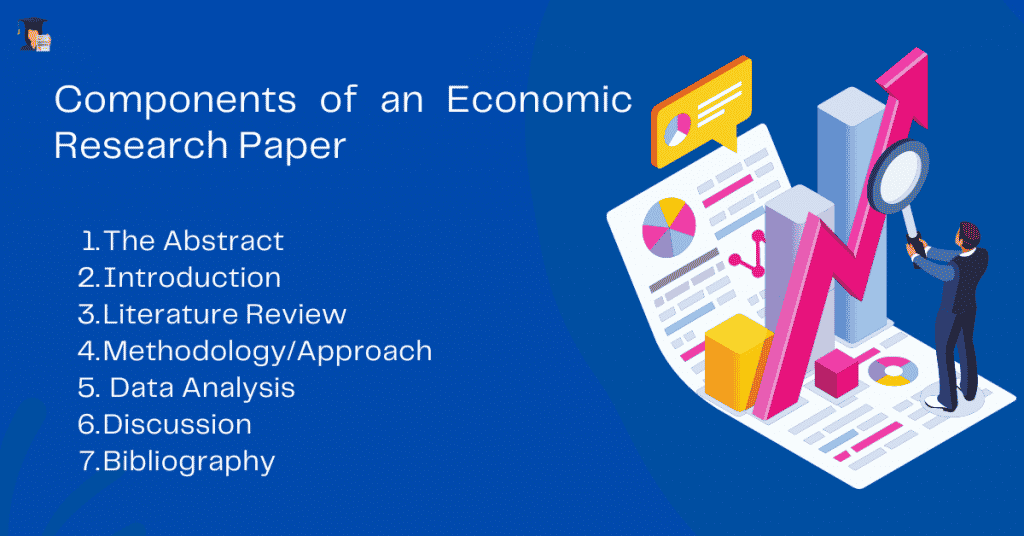
Components of an Empirical Research Paper
Below is what an empirical research paper comprises of:
Abstract
The abstract of an empirical economic research paper briefly summarises your research’s main findings. It should include a brief description of the research design, the data sources and methods used, the principal results and conclusions, and implications for policy or further research. The abstract should be no more than a few hundred words and be clear and concise. The purpose of the abstract is to give your readers a quick overview of the paper so they can decide whether to read the entire document.
Introduction
The introduction section of an empirical economic research paper typically contains three components:
- A description of the problem investigation.
- A review of the relevant literature.
- A statement of the paper’s hypotheses.
In many cases, the introduction will briefly discuss the data and methods you used to test the hypotheses. The purpose of the introduction is to provide the reader with a clear justification for the paper’s existence. By describing the problem and reviewing the literature, you can demonstrate a gap in the existing research that their paper seeks to fill. Furthermore, by stating your hypotheses upfront, you can provide a clear roadmap for the rest of the document.
Literature Review
A literature review is a survey of existing work on a given topic. The first step in writing a literature review for an empirical economic research paper is identifying the relevant literature. Typically, this will involve searching through academic databases such as EconLit or JEL. Once the relevant literature is specified, the next step is critically evaluating it. This means assessing the research quality and identifying gaps in the existing body of work. Finally, your literature review should be synthesized into a coherent argument that sets up the empirical research presented in the paper.
Empirical Methodology
The empirical methodology section of empirical economic research writing sets out the procedures that will be used to test the hypotheses set out in the paper. The empirical methodology section of empirical economic research writing includes:
- The data description- Your description should include information on the source, the period covered by the data, and the variables included in the data set. It allows you to describe the data used in the study and provide a brief description of any processing done to the data before analysis.
- The preliminary data includes specifying the type of data you will use, how it was collected, and how it will be analyzed. The choice of data and methods will be driven by the research question being addressed. For example, if the question is about consumer behavior, then data on consumer spending patterns would be needed. Once the data has been collected, it must be cleaned and processed to remove any errors or biases. Only then can you analyze the answer to the research question. The analysis results should be presented and discussed in light of the literature on the topic.
- The regression equation- A regression equation is a statistical tool used to determine the relationship between two or more variables. In empirical economic research, regression equations are often used to assess the impact of one or more independent variables on a dependent variable. For instance, you might want to know how changes in interest rates affect consumer spending. In this case, the dependent variable would be consumer spending, and the independent variable would be interest rates.
Empirical Analysis
The empirical analysis section of empirical economic research writing is where you present your empirical findings. In this section, you first describe the data you used for the analysis and how you collected it. Next, you discuss the empirical methods used to analyze the data. Finally, you present and interpret your empirical findings. The empirical analysis section is crucial because it allows readers to see how you arrived at your conclusions and assess your study’s strengths and weaknesses.

Conclusion
The conclusion section of empirical economic research writing is where you sum up the study’s main findings. This section should be concise and to the point, as the reader will likely have already made up their mind about the paper by this point. So, the conclusion should confirm the hypotheses tested in the study and discuss any implications of the findings. In addition, the decision should offer a brief overview of the methodology used in the study and suggest avenues for future research.
References
The reference section is an integral part of empirical economic research writing. It should include all the sources you used in the form and any other relevant literature. The references should be arranged alphabetically by author and then chronologically within each author.
For each source, complete bibliographic information should be given, including the author, title, journal, year, and page number. The reference section should also include a brief description of each source. It will help the reader to understand how the original was used in the paper and evaluate its relevance.
The Writing Process for an Economic Research Paper
So now that you have a clear understanding of the definition of an economic research paper and the different types of it. It is now time to begin writing your paper. Writing is the most complex part of it all. By following the steps below, you can produce a well-written paper. So let us attentively go through them:
Find the research topic
When writing your economic research paper, finding a good topic is essential. There are a few things to keep in mind when choosing a topic. First, ensure that the case is exciting and relevant to current economic conditions. Second, the matter should be something that can be researched thoroughly. Third, your topic should be something that you are personally interested in. Ensure you can narrow down your choices and choose a topic that will be both engaging and informative.
Draft the title
One of the most critical steps in writing an economic research paper is drafting a title that accurately reflects the paper’s contents. The title should be concise and specific, giving readers a clear idea of the paper’s discussion. In addition, the title should be easy to find when potential readers are searching for documents on similar topics. For these reasons, it is vital to take the time to craft a well-thought-out title before beginning the rest of the paper.
Draft an outline
In this section, you will map out the design of what you are to write. Outlining will allow you to organize your ideas and thoughts and logically present them. You should carefully draft your outline because it will give you a more effortless flow of work as you write your economic research paper. So ensure that you provide all the critical information you have found in the document.
What your outline will comprise of:
- Title of the paper.
- Your thesis.
- Main points.
- Your hypothesis.
Researching and using sources
One of the most important aspects of writing an economic research paper is choosing and using sources effectively. Sources can provide essential data and information, help to support your argument, and add credibility to your writing.
However, it is crucial to consider their reliability and accuracy. Check the author’s or organization’s credentials and look for reviews or other independent verification of the information. It is also essential to consider the bias of a source. All sources will have some bias, but you should try to choose sources that present a variety of perspectives.
Once you have found appropriate sources, cite your sources appropriately to give credit where it is due and avoid plagiarism.
Write an Abstract
An abstract’s purpose is to summarize your research paper’s critical points. The abstract should be one paragraph, between 150 and 250 words long, and you should write it after finishing the rest of your paper. The first step in writing an abstract is thoroughly examining your document and distilling its essence.
- What are the main points that your paper is trying to make?
- What are the supporting arguments or evidence?
Once you have a good understanding of the overall argument of your paper, you can start to distill it down into a single paragraph. The goal is to communicate the critical points of your paper without getting bogged down in too much detail. Finally, once you have a draft of your abstract, read it carefully and make any necessary revisions.
Write the introduction
The introduction is the most crucial part of your paper as it aims to alert the reader to the importance of your topic. The first step in writing a solid introduction is to grab the reader’s attention with a hook. The hook can be a quote, an interesting statistic, or a rhetorical question.
Once you have the reader’s attention, you must provide background information on your topic. It will help the reader understand why your research is essential. Finally, you need to state your thesis. The thesis is your paper’s central argument and should be clear and concise. After reading your introduction, the reader should know what you will argue about and why it is crucial.
Write a Literature Review
The literature review is a section in a dissertation or research paper where you must summarise existing research information from different scholars. It should be done before starting your research as it will show the investigation and the gaps that you need to address. The literature review also provides a solid background for the reader to understand what you are doing and why.
The primary purpose of writing a literature review is to establish your position (stance) on the issue being discussed and to justify this position concerning existing knowledge. The literature review forms the basis of your research paper. It shows that you can: find relevant scholarly sources, critically read and evaluate them, synthesize findings from several sources, and write a compelling and convincing argument.
Present Hypothesis
The hypothesis is the central idea around which the entire paper will revolve. It should be straight to the point and supported by the evidence you will present in the document. The hypothesis should also be testable; it should be possible to design an experiment or study that would either support or disprove the theory. Once you have developed a strong hypothesis, the rest of the writing process will become much more manageable. The clearer your idea is, the more focused your paper will be, and the easier it will be to convince your readers of your point of view.
Reference your sources
There are three main sources:
- Primary.
- Secondary.
- Tertiary.
You will also need to determine whether you will use qualitative or quantitative data. The next step is to find relevant sources for your paper. It includes searching for peer-reviewed journal articles, government documents, and data from reliable organizations. After finding sources, you will need to read and take notes on the most relevant information to your paper. The final step is to write your document using the information you have gathered from your sources.
How to Format an Economic Research Paper
Formatting your economic research paper correctly may seem like a small detail, but it can make a big difference in the overall quality of your work. Here are the specific requirements you need to pay attention to:
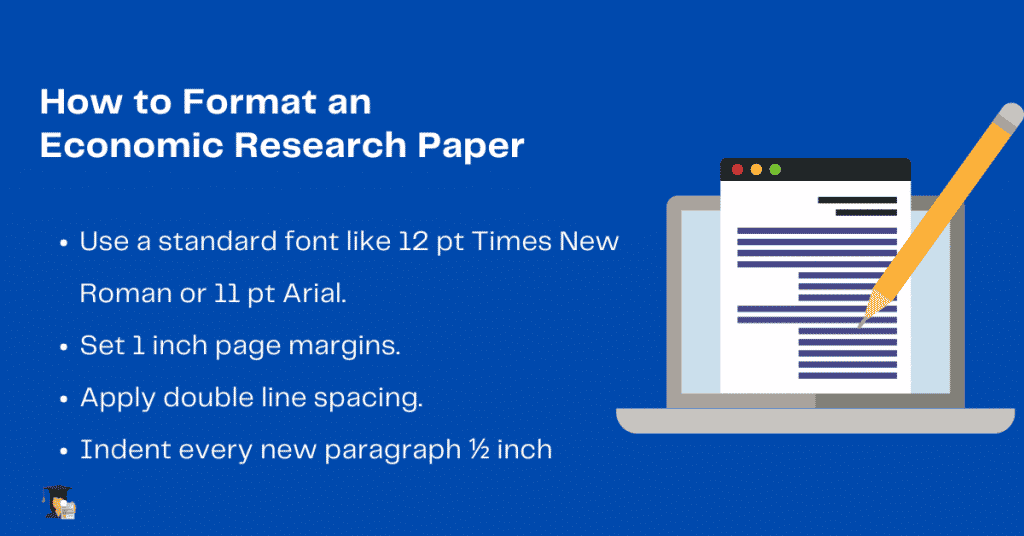
Font– The font size and type you use for your paper should be easy to read and consistent throughout your writing. Many economists prefer to use a serif font such as Times New Roman for their documents. The standard font size when writing an economic research paper is 12-point.
Margins– The margins of your paper should be one inch on all sides of the page. Your text should align to the left side of the page, with each new paragraph indented half an inch from the left margin.
Space– Your economic research paper should be double-spaced, with no extra space between paragraphs to make it visually appealing with a clear workflow. Many students forget to include this element when formatting their papers, making them appear cluttered and difficult to read.
Tips on How to Write a Successful Economic Research Paper
A few key things to remember when writing an economic research paper will help ensure your success. Following these simple tips, you can set yourself up for success when writing your following economic research paper.
Ensure your subjects are short
Ensure your topic matter has enough information to share with your readers. Do not make it too long; papers that try to cover too much ground tend to be unfocused and scattered, making them difficult to follow and understand.
Analyze instead of analysis
This means diving deep into the data and understanding what it tells you, rather than simply heading straight to provide a surface-level summary with no clear knowledge.
Sentence structure matters
When introducing new information, start with old data and move on to the new one. It helps provide context and ensures that your reader can follow your train of thought.
Avoid Passive Voice
This can make your writing sound weak and indecisive. Instead, use an active voice to give your sentences more impact.
One Paragraph = One Thought
Remember that one paragraph should equal one thought. It will help to keep your paper focused and easy to follow.
Final Thoughts
There you have it! With the guide we have provided for you on how to write an economic research paper, we hope that it will be helpful for you to understand the basic format of the research paper and essential tips that will give you a good starting point for writing your following economic research paper.
We hope the article is helpful. Leave a comment down below. Remember, if you need help along the way, our team of experts at Bright Writers is here to assist you. Good luck and happy writing!
What is the format of an economic paper?
The basic format of an economic research paper includes:
- The introduction.
- The body ( Literature review, data analysis, and your hypothesis)
- The conclusion.
What are the steps in economic research?
The research question.
Literature of the topic.
Analysis of the research paper.
Report of the research findings
Discussion of the findings.
Conclusion of the research
How do you write an economic introduction?
The introduction introduces the topic and provides background information about the issue. You should ensure that it is clear and straight to the point for the readers to understand the paper well.


